Engineers on the Peninsula
Experience and Legacy of the 52d BEB During KRF-13
By Major Jared R. Stefani and Captain Scott C. Blackstock
Article published in: January 1, 2024 in the Engineer 2024 Annual Issue
Read Time: < 9 mins
DOI: https://doi.org/10.21236/AD1307130
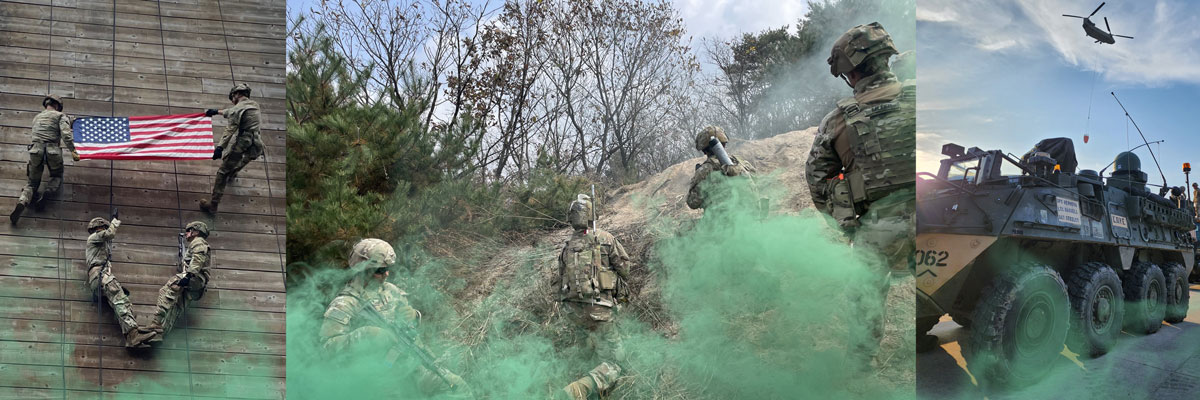
The Korean Peninsula has long been a focal point of geopolitical tensions; as a result, U.S. forces have maintained a presence there for the past 70 years. The primary objective of these regional forces is to deter aggression from North Korea while safeguarding U.S. interests in the Indo-Pacific Command (INDO-PACOM) area of responsibility. Establishing a credible military deterrence requires the presence of highly skilled and adaptable military forces. Combat engineers notably stand out as a vital component for enabling maneuver and fires brigades to accomplish their missions. Furthermore, recent developments in modern military operations, exemplified by events in Ukraine and combat operations in Gaza, underscore the enduring significance of engineers. Now more than ever, highly trained and prepared engineers are crucial in enabling maneuver forces to fight and win on diverse and complex battlefields.
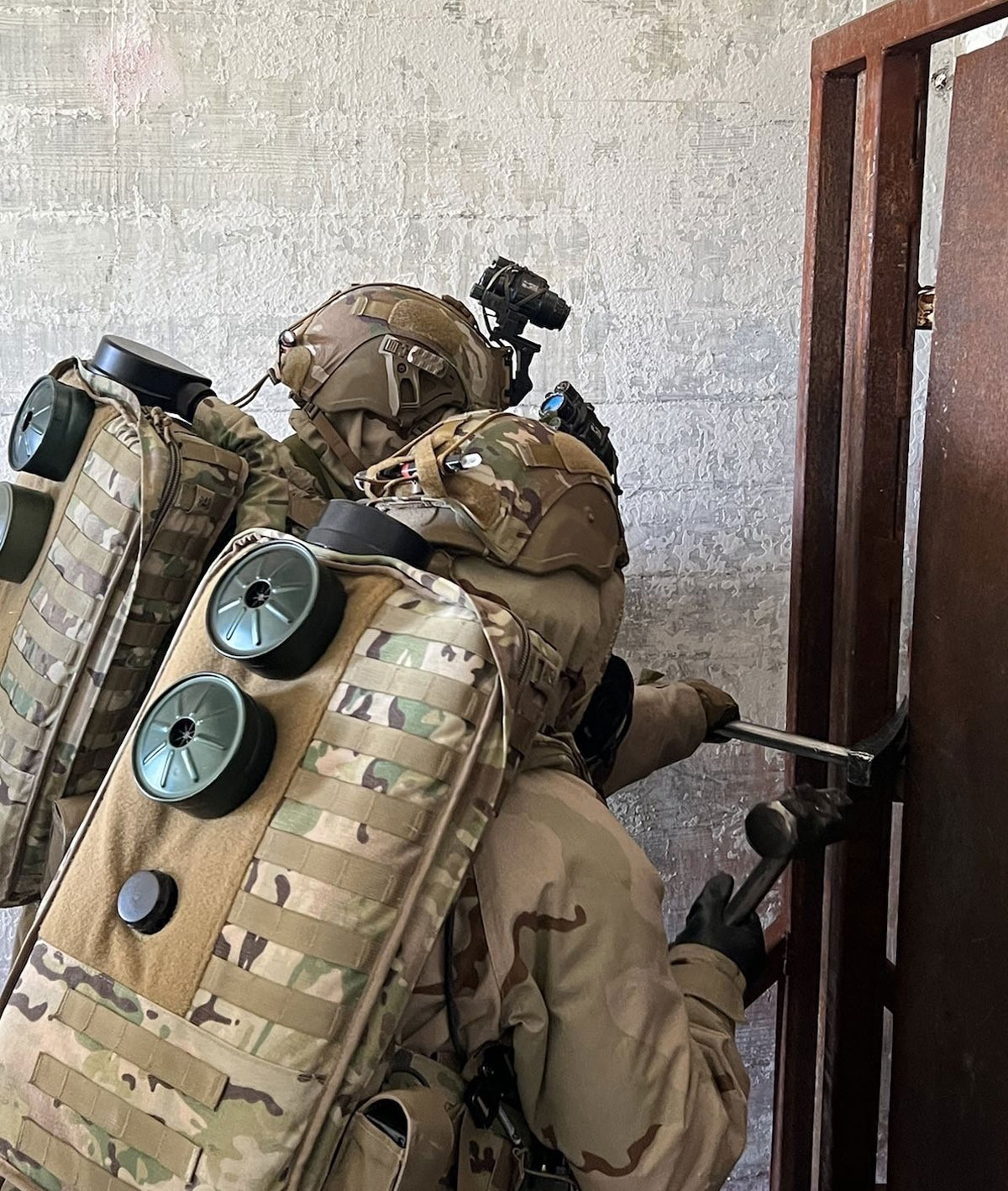
Soldiers breach a mechanical door.
As part of a cost savings model, brigade combat teams (BCTs) are rotated to Korea, rather than being permanently stationed there. Based on capabilities established and dynamic training plans executed during the deployments, the Korean Rotational Force (KRF) should be renamed the Korean Response Force. The 52d Brigade Engineer Battalion (BEB) (Five Deuce), Fort Carson, Colorado, is currently assigned to KRF-13, Camps Casey/Hovey, Republic of Korea (ROK). KRF-13 represents the 13th rotation of a BCT to Korea on a 9-month deployment; however, it is only the second iteration in which a Stryker brigade combat team (SBCT) has been sent to the Korean Peninsula. Building on the successes of the first SBCT rotation to Korea, the 52d BEB and the 2d SBCT, 4th Infantry Division (ID), have provided new capabilities and training strategies to increase overall unit and Republic of Korea Army (ROKA) training readiness. While a brigade permanently assigned to Korea would provide operational continuity and uninterrupted ROKA integration, the response brigade concept allows the flexibility to rotate units in and out based on operational needs and enables opportunities for rotating units to train in different environments and scenarios. Because the current model is expected to remain in place for the foreseeable future, incoming rotational units should capitalize on the successes of Five Deuce and benefit from its hard-earned lessons.
Rotational brigades fall under the 2d ID, a combined division made up of U.S. Army and ROKA service members integrated at all levels, from squad to division. Beyond enhancing the lethality of the Korean service members training alongside U.S. forces, this integration facilitates cultural understanding and fosters positive interactions with external ROKA units and community members. ROKA staff officers and Korean Augmentation to the U.S. Army (KATUSA) personnel assigned to the Five Deuce help plan and execute training events with partnered ROKA units across the peninsula. These combined training events significantly boost interoperability—a crucial element for operational and strategic success since the U.S. Army almost always operates within a multinational operations framework. Five Deuce has successfully executed numerous combined training events and cultural exchanges, fortifying the asymmetric advantage of the United States over its adversaries and reinforcing ROKA partnerships by maintaining a robust network of partners and allies. A collaborative approach at these levels underscores the importance of international cooperation for success on the peninsula.
The 52d BEB is the principal enabler integrator for the 2d SBCT, 4th ID. It provides the 2d SBCT with a spectrum of capabilities ranging from engineering operations to chemical, biological, radiological, and nuclear reconnaissance; signal support; dynamic collection and targeting; and sustainment operations. Operationalizing training is a formidable challenge, given its command of 17 platoons with 14 distinct and unique mission sets. Compounding this complexity, the 52d BEB was required to navigate new and foreign bureaucratic hurdles to establish a clear pathway for its training progression in alignment with its mission-essential task list (METL) in Korea. In addition to its METL, the 52d BEB embraced another new mission during KRF-13, noncombatant evacuation operations (NEO). NEO involve evacuating civilians, including embassy personnel and military dependents, from a foreign country in crisis or conflict. Five Deuce carefully balanced its METL requirements with the development of new skills to meet the NEO mission. Never one to “fake the funk,” Five Deuce expanded its collaboration with external agencies like the U.S. Department of State and ROKA units, fully operationalizing and executing its NEO mission during the 8th Army annual crisis management training exercise, Courageous Channel 23.
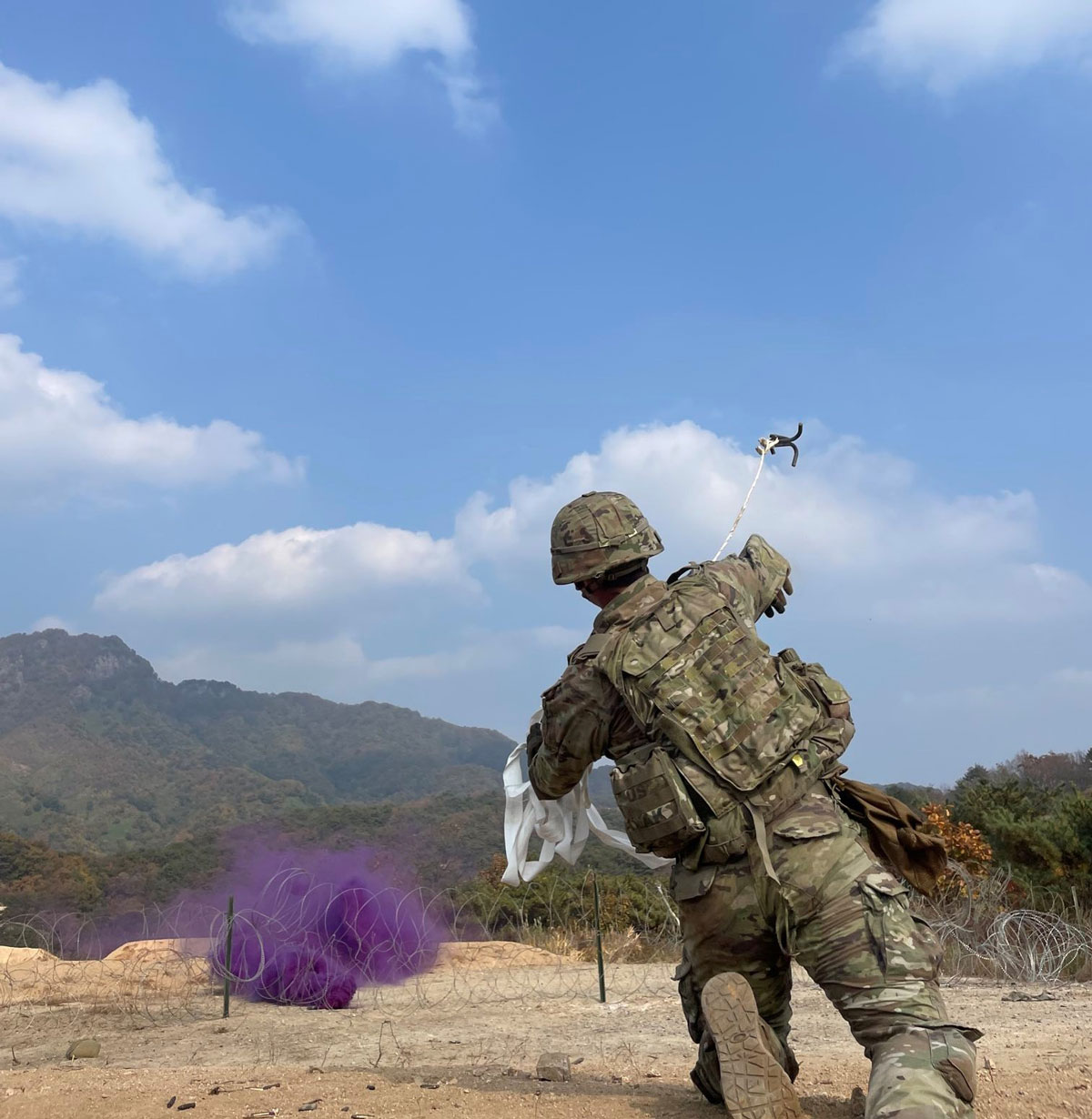
Sapper conducting EQT V.
Prior to the transition to SBCTs, armored brigade combat teams (ABCTs) were the brigade of choice in Korea. However, as the Five Deuce is currently demonstrating, SBCTs are well-suited for the diverse and challenging terrain of the Korean Peninsula, which ranges from urban to mountainous areas. The versatility of the Stryker allows engineers to navigate the various environments to reach their objectives. And the rapid deployment and high mobility provided by the Stryker allows brigades to reach their objectives faster and with more tools and supplies than light units can, creating a more significant effect for maneuver forces; this also expands the fighting capability beyond the open terrain or roadways that are required by heavy units. In addition, the Stryker protects Soldiers against enemy small-arms fire and one of the deadliest adversaries in Korea—the weather. Moreover, ABCT maintenance can consume considerably more time on a unit training calendar. In short, the SBCT is a force multiplier that gives commanders more decision space at echelon. While participating in KRF-13, the 52d BEB continues to test new tactics, techniques, and procedures for Strykers, gaining a greater understanding of how Strykers may be used across INDO-PACOM.
Due to additional emphasis on dismounted operations across an SBCT, Five Deuce sapper squads train to conduct dismounted explosive breaches for Stryker-sized lanes. Training for this mission has been difficult in Korea due to the limited number of training areas that allow engineer qualification table (EQT) certifications encompassing Soldier and leader skills, mobility situational training exercise lanes, and live-fire in conjunction with an explosive breach.
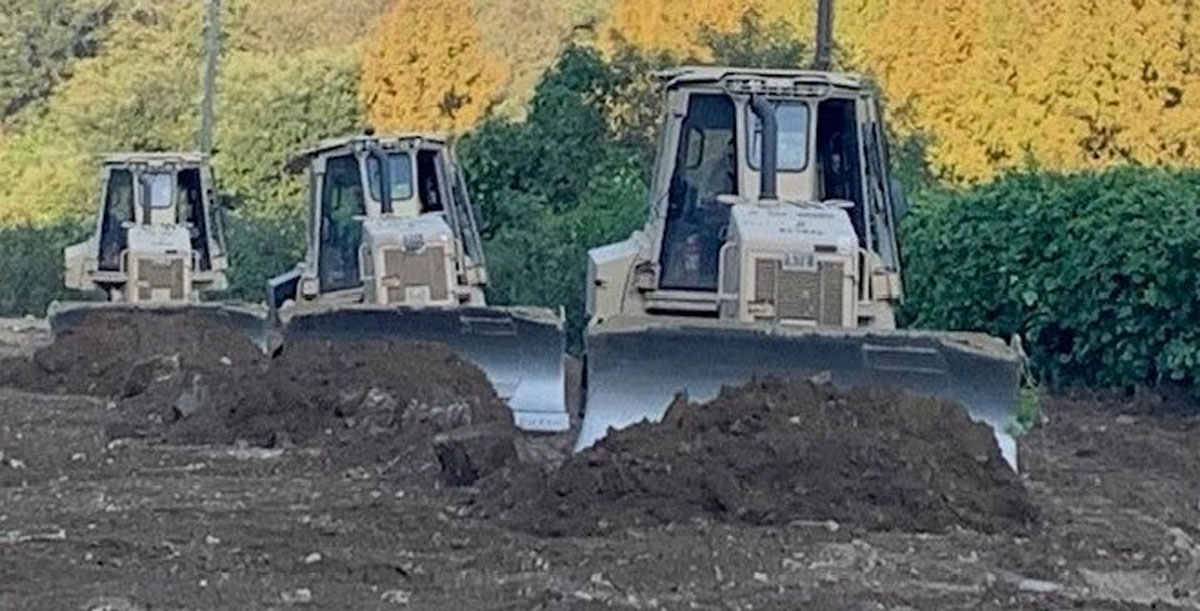
52d BEB constructs survivability positions.
Historically, engineers had only one location where they could conduct live demolitions in conjunction with live-fire exercises—the Digital Multipurpose Range Complex on Rodriguez Live-Fire Complex, ROK. All units use this training site for mounted machine gun gunnery, so it is consistently reserved by units across the peninsula. Previous KRF and permanently stationed units found it necessary to administratively separate their EQT V requirements, designating a live-fire lane for fire control measures and an offset explosive breach at an alternate training area. However, this approach was not realistic or compatible with the lethal mindset of Five Deuce. Given the limitation of one U.S. range in Korea capable of accommodating EQT V, the 52d BEB sought to expand the number of ranges capable of fulfilling the training objective.
Through a comprehensive education process in which the 52d detailed the minimal risks of demolition effects simulators and the profound benefits of realistic EQT training they provide, Camp Casey range control authorized the use of demolition effects simulator charges in its training areas. This authorization significantly enhanced the opportunity for sappers to train on Camp Casey and increased the potential for the future training of engineers, infantry, and scouts there. This was the first of many victories for the Five Deuce in Korea. Ultimately, two ranges were authorized for EQT V certifications. As the BEB continued to push, it was able to certify its engineers’ ability to conduct fire control measures with a complete explosive breach and lane marking—a first in several years in Korea. This effort enabled engineers to be fully integrated into the 2d SBCT, 2d ID, culminating event—a combined arms live-fire exercise in 2024.
Five Deuce engineer capabilities extend beyond sappers, encompassing two engineer support platoons (ESPs) designed to deliver horizontal-construction engineer support to the 2d SBCT and the 210th Field Artillery (FA) Brigade, Camp Casey. Since artillery remains the “King of Battle” in Korea—just as on any battlefield—the Five Deuce ESPs trained extensively with 210th FA Brigade and ROKA engineers on providing survivability positions to protect valuable assets. The creation and execution of ESP EQTs that were aligned with 52d BEB KRF requirements ensured that BEB Military Occupational Specialty (MOS) 12Ns Horizontal Construction Engineers were certified in their assigned mission to meet the commander’s intent. This enabled subordinate units to have a specified training progression that mirrored the structure of sapper EQTs. The training plan for the ESPs culminated in a platoon survivability exercise that seamlessly integrated the 210th FA Brigade and ROKA counterparts.
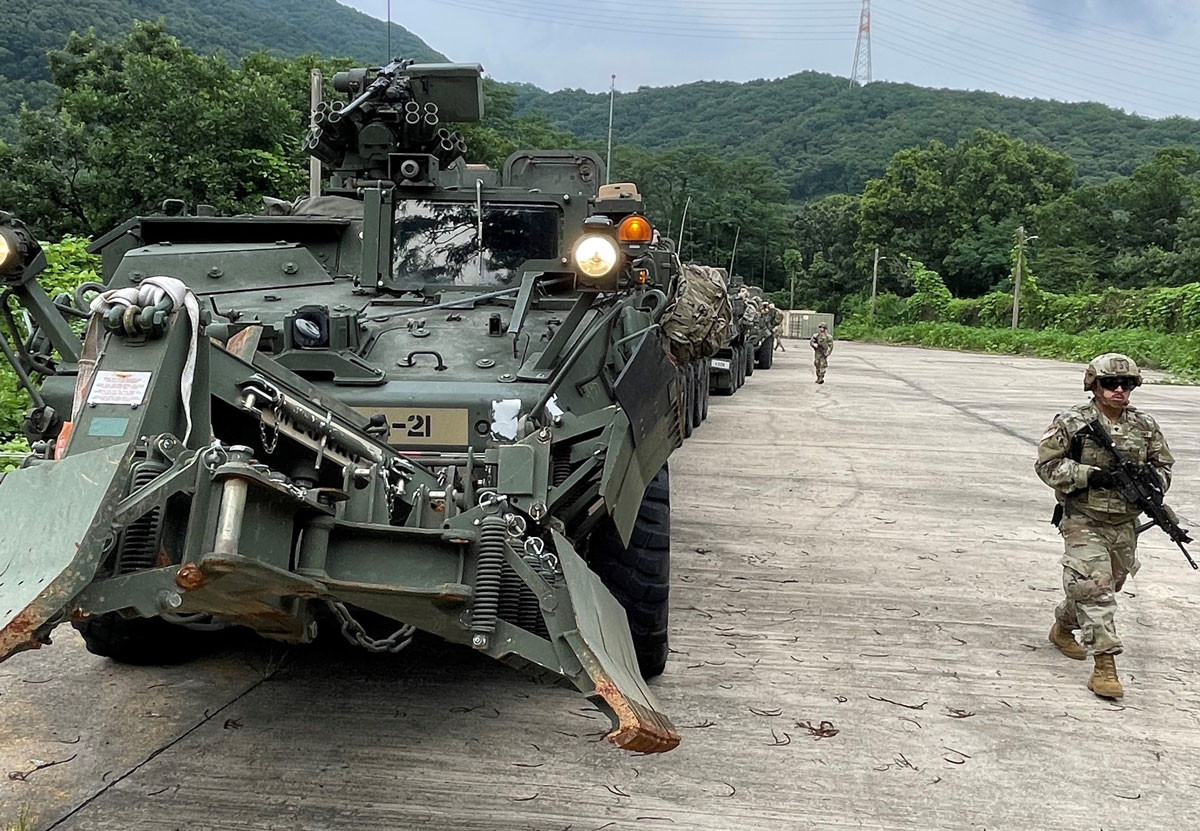
Sappers conduct a deployment exercise on Camp Hovey.
Units in Korea must be “Ready to fight tonight—and win.” To be “ready” implies a constant preparedness to perform unit functions and missions, which is achieved by rapidly increasing the ability to muster and maintain a high state of alert. The BEB amplifies readiness and enables brigades to fight and win. While the division is now the decisive tactical unit for large-scale combat operations, division staffs are already too overburdened with assets that must be controlled and providing lower-echelon unit commanders with command and control of enablers ensures that their formations remain lethal. Brigades still need to be connected to enabler units such as the BEB. Until a decision is made about BEB divestiture, engineers and other enablers within the battalion must double down on their efforts to integrate and enable maneuver units to move, communicate, collect, and target enemy forces.
The 52d BEB KRF-13 deployment has been enabled by leaders who have focused on and demanded realistic, complex training that has further increased the lethality of the BEB, its supported maneuver battalions, and its ROKA partners. Five Deuce partnerships have improved the effectiveness of ROKA engineers and fostered strong diplomatic ties that have strengthened regional stability. The 52d BEB breached bureaucratic obstacles and established a lane for future rotational units to continue the fight to deter North Korean aggression while increasing the lethality of ROKA partners. Deployments to Korea will remain critical as a testing ground for determining how the BEB and SBCT will fight and win in the INDO-PACOM area of responsibility. As the 52d BEB prepares to redeploy to Fort Carson, the legacy of its training excellence will endure, providing valuable lessons for future units assigned to KRF to meet the demanding training environment of the Korean Peninsula. Five Deuce! Led by love of country! Essayons!
Authors
Major Stefani is the operations officer for the 52d BEB, 2d SBCT, 4th ID, and is currently deployed to KRF-13. He holds a bachelor’s degree in political science from the University of Portland, Oregon, and master’s degrees in security studies from Georgetown University, Washington, D.C.; geological engineering from the Missouri University of Science and Technology at Rolla; and operational studies from the Army University Command and General Staff College, Fort Leavenworth, Kansas. He is a licensed project management professional, a strategic studies graduate, and master teacher graduate.
Captain Blackstock recently commanded Company B, 52d BEB, which included a year of training progression and troop construction, a combat training center rotation, and a deployment in support of KRF-13. He holds a bachelor’s degree and is currently pursuing a master’s degree in environmental engineering from the University of Georgia.